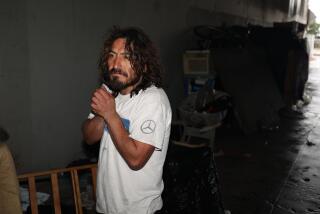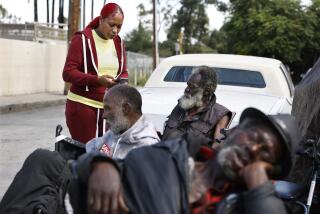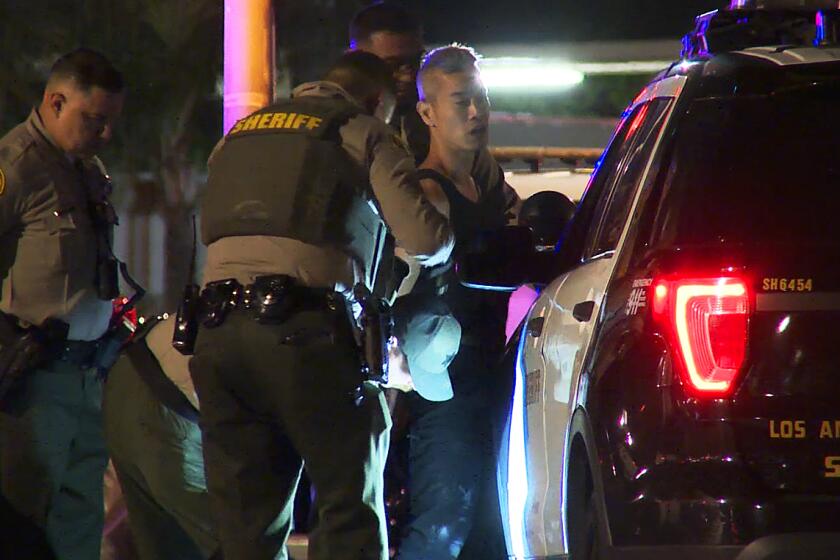Advocates reach out — way out — to get homeless out of riverbed
Benny Perea, a veteran of two wars, found himself at age 78 sleeping on a mattress behind a liquor store and hanging out in homeless encampments along the San Gabriel River.
He once owned a home in Baldwin Park and worked as a plumber for the Chevron refinery. But he struggled with addiction and saw his marriage fail.
“It’s going to happen to everybody all over the world, when you wake up one day and you have nobody but yourself,” Perea said.
Despite entreaties from advocates for the homeless, Perea had resisted moving to an apartment. But last month, when a county worker showed him a photo of his family, Perea cried — finally ready to come in.
He is one of the hard-core homeless people who have been targeted in the last two months by a $175,000 Los Angeles County outreach effort focused on rugged areas that officials hope to turn into a chain of parks they call the Emerald Necklace.
Launched at the end of July by Supervisor Gloria Molina, who has directed $5 million to the parkland effort, the project sends teams into the brush-choked back alley of some of L.A.’s densest communities with offers of shelter, medical and mental health treatment and drug counseling.
Loosely patterned on programs in Salt Lake City, New Orleans and New York City, the project marks a shift in thinking about chronic homelessness, which local leaders have promised to end by 2016.
Where advocates once tried to help people living on the streets with blankets and food, and law enforcement rousted them, the teams are spending months earning their trust and getting them threshold services they need to qualify for housing.
The approach has been used successfully on skid row and at the Los Angeles County-USC Medical Center emergency room, which homeless people were using as a de facto shelter, said Jeanette Rowe, director of outreach for the Los Angeles Homeless Services Authority.
Under New York City’s program, street homelessness declined 28% in eight years, and Central Park was largely rid of encampments, officials there said.
“We’re realizing we need to go to homeless people rather than expecting them to come to us,” said Michael Arnold, executive director of L.A.’s homeless authority.
By last week, team members had talked nearly a third of the 156 people they engaged into using services. Only 13 were in housing, but the 90-day project is still underway and can be extended if needed, Rowe said.
“We are connecting them with shelter and services — a process that takes several weeks, sometimes months,” Molina said.
Outreach workers went to considerable lengths to persuade homeless people to come in, including taking care of their pets and scrambling up slippery freeway embankments to find hidden sleeping quarters.
“A lot of people want help; they just don’t know how to get it,” said Angel Espinoza, an outreach worker with Behavioral Health Services Inc., a community-based agency focused on substance-abuse recovery.
Espinoza, a 40-year-old former heroin addict who said he was first homeless at age 10, spent weeks building trust with people like Jerry Butler.
Butler and her boyfriend were living in an encampment under a freeway bridge with a dozen people, recycling for grocery money and showering with a hose and tarp she rigged in the back of a nearby nursery.
She agreed to spend a night in a motel so she could get a pregnancy test. It was positive. Butler was back in the riverbed the next day.
Many homeless people miss the safety and companionship they find in the encampments, Espinoza said. The riverbed was full of substance abusers, he added. Other people had mental health issues, and most had experienced trauma.
George Holling, 39, said he’d been on the streets since he was 9. The team came upon Holling and his wife, Tamiko, 38, camping under a tree with their dogs.
Sheriff’s deputies said they were too close to a school field, so they relocated across the shallow river by bicycle, with Holling hauling their belongings on his back.
“This is a game of life and death,” said Tamiko, whom the team set up with a mental health appointment. Holling spent years recovering after being struck by a train on nearby tracks, he said.
The Sheriff’s Department has reported four deaths in the riverbed this year, including a murder. Tamiko said junkies found an overdose victim with a half-full syringe hanging from her arm. They used the drugs and stuck the needle back in, she said.
The outreach teams coordinate with law enforcement, encouraging the residents to clear out before their makeshift homes are dismantled. Two weeks ago, sheriff’s deputies closed down several encampments.
Capt. Christopher Nee stepped on a board studded with nails hidden under brush at a door marked “Do Not Enter.” A booby trap with a mousetrap and a trip wire designed to set off a shotgun shell was at another dugout, he said.
One three-room bunker was equipped with a generator, flooring and a desk and chair. Another had a dock for the owner to launch his raft to the other side of the river, said Nee, adding that it reminded him of Tom Sawyer’s Island.
“It was not our intent to make arrests,” said Nee, adding that signs were posted in advance notifying the homeless about the raid. “Our true goal was to get people into treatment and get them help.”
Espinoza said law enforcement sometimes destroys the IDs and other papers homeless people need to get aid.
“We’re not always on the same page,” said Oscar Polanco, a senior emergency response team member for the homeless authority.
Under a bridge, self-proclaimed “mayor” John Leyba presided over a tent city. Leyba, who greeted visitors under a flagpole flying the American flag, lost his job four years ago. His wife, Kathryn Carroll, a former publicist for a punk rock label, had lost her job, home and truck in quick succession.
Carroll showed visitors the remnants of an earlier encampment — created by a friend out of salvaged material — that she said had a door, blinds and a wet bar with a stripper pole. They regrouped after police tore down their makeshift shelters.
Leyba and Carroll were among the few riverbed dwellers free of drugs and alcohol or mental health issues, team members said. But they wouldn’t leave unless all their constituents could come, too.
“They say they’re good, help everybody else,” Polanco said.
In Perea’s case, the outreach team pieced together his story and obtained a photo of family members, who had thought he was dead.
He agreed to go through drug detoxification. His first night in an apartment in Long Beach, he got mugged at the bus station.
Espinoza found him the next day in the riverbed and brought him back to the apartment.
Espinoza said that relapses are common among longtime street homeless and that he had gone through detox twice before becoming clean three years ago.
Now, he said, he wants to repay the help he received along the way, aiding people like Perea: “I never give up. No, never.”
More to Read
Start your day right
Sign up for Essential California for news, features and recommendations from the L.A. Times and beyond in your inbox six days a week.
You may occasionally receive promotional content from the Los Angeles Times.






